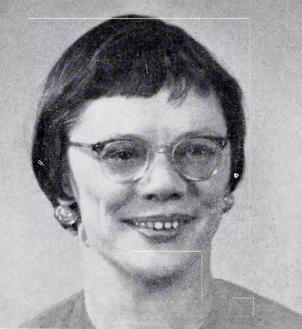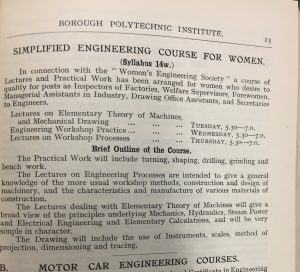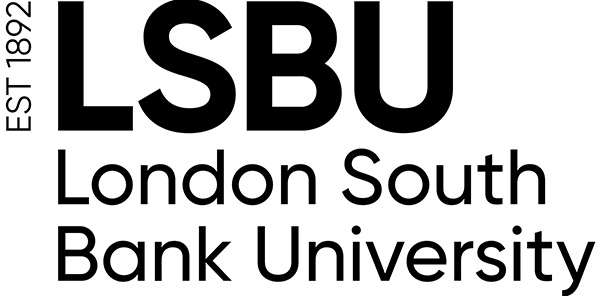 In 1930 the Borough Polytechnic advertised “Simplified Engineering for Women”, offered in connection with the Women’s Engineering Society. The course covered Engineering Workshop Practice, Elementary Theory of Machines and Technical Drawing, and Workshop Processes. From the exam registers it seems that not many women did the full course, although it’s possible that not all of it was examined – the records just don’t tell us. What they do tell us is that women were starting to do other courses within the Engineering Department.
One of those women was Madeleine Nobbs, who started taking courses in the academic year 1938-1939. Madeleine later became President of the Women’s Engineering Society and their journal, The Woman Engineer, has both a summary written by her of her career and an appreciation written after her death in 1970. This means that, unlike some of our former students, we know exactly what she did after she finished her studies. When she left school Madeleine started working as a shorthand typist, which she described as “disastrous”. In her article in the Woman Engineer she writes about thinking of the subjects she did well in at school, then reading a book on Technical Drawing which led her to tell her engineer father that she also wanted to be an engineer. His initial reluctance was eventually overcome when he met another woman engineer, and Madeleine was able to get a job as a junior in a heating contractor engineer’s office. Her salary was £2 10 0d a week, which she says was less than half of her previous salary, and she was allowed a day a week to do a part-time day release course at the Borough Polytechnic.
Her courses included Engineering Drawing. Materials and Processes, and Geometry, all of which our exam registers tell us she passed with Distinction. In her 2nd year she won the prize for the Heating and Ventilating part-time day course. The course also included Heating and Ventilation, Mathematics and Engineering Science. After she finished her studies she was involved in designing air raid shelters, factories and boat ventilation – although restrictions from dockyard authorities, presumably around the presence of women, meant that she wasn’t allowed to inspect ship installations. She later changed firms to get a range of experience before going to her father’s firm as an engineer and then a junior partner. When he died, she took over the firm and became a consultant engineer.
More about Madeleine’s career, and what her work involved, can be found in The Woman Engineer, vol 10, no’s 18 and 20.
In 1930 the Borough Polytechnic advertised “Simplified Engineering for Women”, offered in connection with the Women’s Engineering Society. The course covered Engineering Workshop Practice, Elementary Theory of Machines and Technical Drawing, and Workshop Processes. From the exam registers it seems that not many women did the full course, although it’s possible that not all of it was examined – the records just don’t tell us. What they do tell us is that women were starting to do other courses within the Engineering Department.
One of those women was Madeleine Nobbs, who started taking courses in the academic year 1938-1939. Madeleine later became President of the Women’s Engineering Society and their journal, The Woman Engineer, has both a summary written by her of her career and an appreciation written after her death in 1970. This means that, unlike some of our former students, we know exactly what she did after she finished her studies. When she left school Madeleine started working as a shorthand typist, which she described as “disastrous”. In her article in the Woman Engineer she writes about thinking of the subjects she did well in at school, then reading a book on Technical Drawing which led her to tell her engineer father that she also wanted to be an engineer. His initial reluctance was eventually overcome when he met another woman engineer, and Madeleine was able to get a job as a junior in a heating contractor engineer’s office. Her salary was £2 10 0d a week, which she says was less than half of her previous salary, and she was allowed a day a week to do a part-time day release course at the Borough Polytechnic.
Her courses included Engineering Drawing. Materials and Processes, and Geometry, all of which our exam registers tell us she passed with Distinction. In her 2nd year she won the prize for the Heating and Ventilating part-time day course. The course also included Heating and Ventilation, Mathematics and Engineering Science. After she finished her studies she was involved in designing air raid shelters, factories and boat ventilation – although restrictions from dockyard authorities, presumably around the presence of women, meant that she wasn’t allowed to inspect ship installations. She later changed firms to get a range of experience before going to her father’s firm as an engineer and then a junior partner. When he died, she took over the firm and became a consultant engineer.
More about Madeleine’s career, and what her work involved, can be found in The Woman Engineer, vol 10, no’s 18 and 20.

Course description, Simplified Engineering for Women, 1930 prospectus

